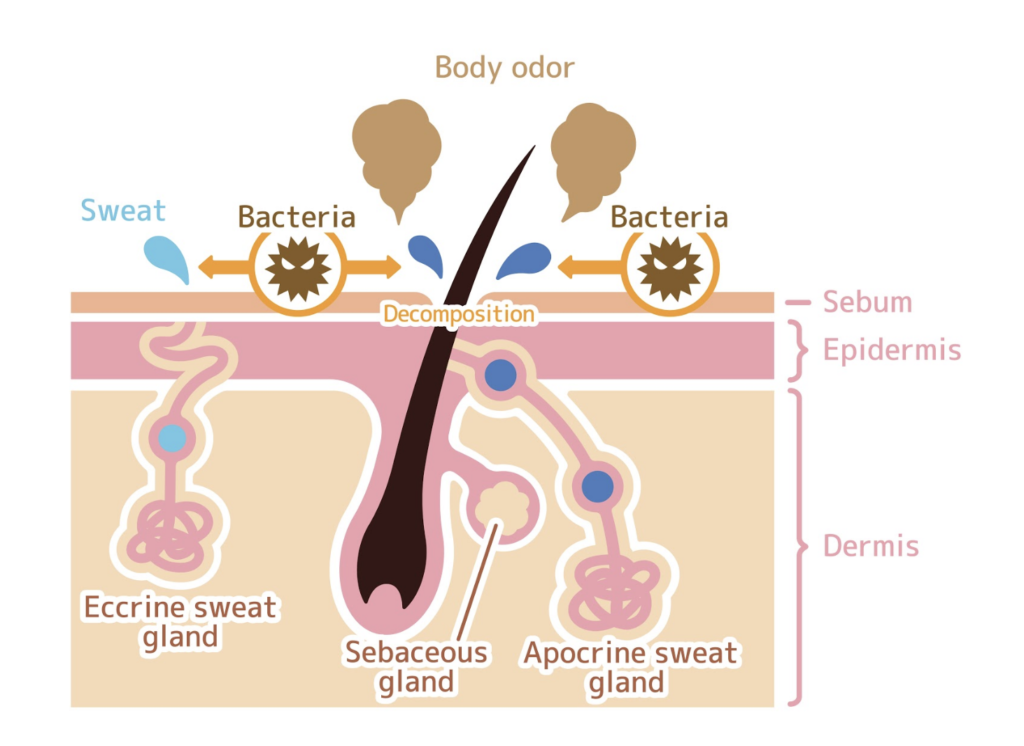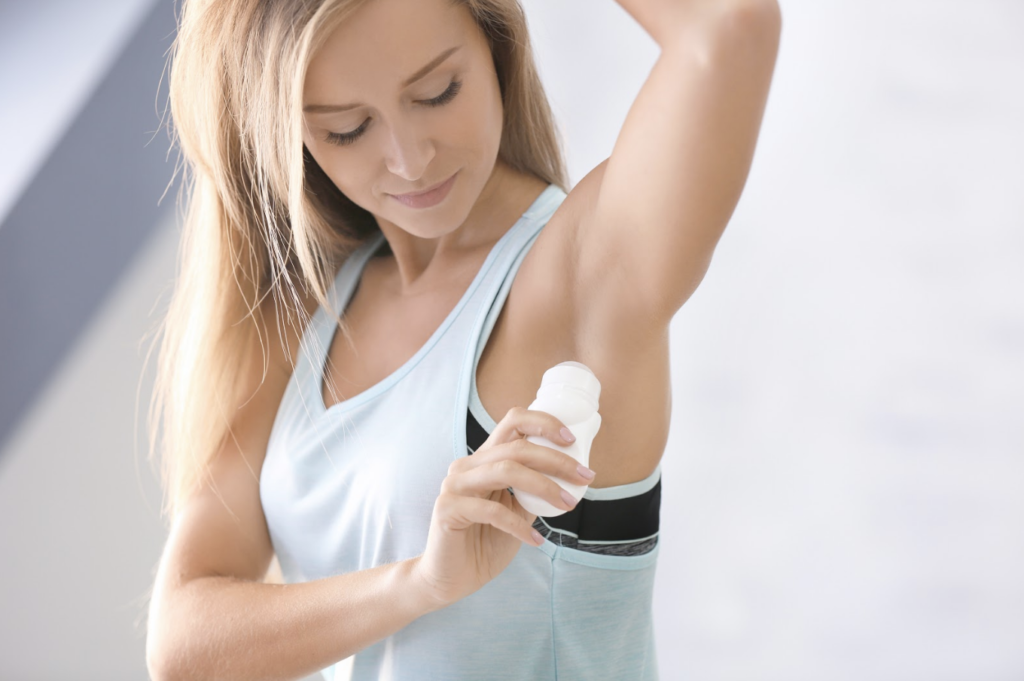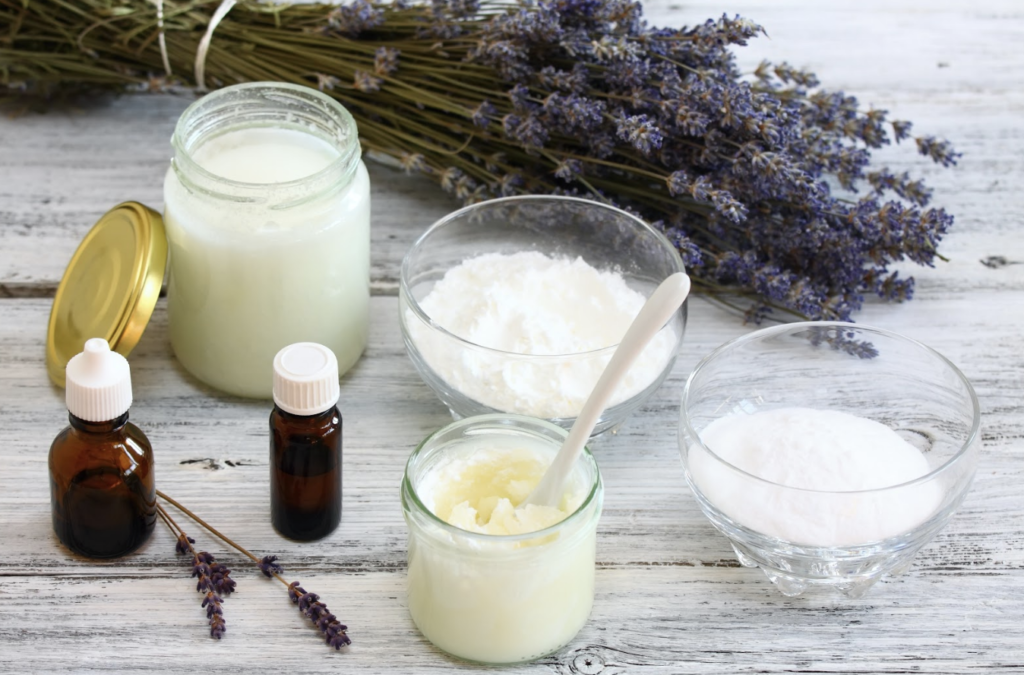Switching to a natural deodorant/antiperspirant that works can be easy if you know what ingredients matter — and which ones to stay away from.
It’s apparent in this day and age that our every-day household and skincare products contain questionable chemicals we want to avoid. When applied to the delicate skin in our armpits, these chemicals may cause irritation, absorb into our skin and might be related to health issues over time, some of which can turn into major problems.
Disclaimer: If you decide to purchase products, you have read, understand and agree to the Terms of Service and our Affiliate Disclosure.
What is the difference between Deodorant and Antiperspirant?
The answer is simple. A deodorant helps with odor and doesn’t prevent you from sweating and antiperspirant helps with sweating. Most over-the-counter deodorants you get at the store have both deodorant and antiperspirant in them.
What causes underarm odor?
In our armpits, we have two main types of glands: eccrine and apocrine glands.
Eccrine glands release salt and water to keep your body cool and do not cause odor.
Apocrine glands secrete a thicker fluid that contains proteins, fats, etc and also do not cause odor…..until they meet up with the microbes on your skin. Microbes that live on the skin break down the apocrine secretions which results in odorous fatty acids.

The release of the contents of the eccrine and apocrine glands is triggered by the nervous system. We have nerve endings that connect to these glands and respond to triggers such as hormones, emotions, exercise and the body’s signaling system indicating your body temperature has increased.
How do deodorants and antiperspirants work?
Deodorants contain ingredients that have a pleasant scent to mask or hide odor and have substances that change the environment of the skin so that it’s more difficult for microbes to grow.
Antiperspirants temporarily block the sweat glands from releasing their secretions. When you sweat and have an antiperspirant on your skin, the antiperspirant ingredients dissolve into the sweat pore and form a temporary plug so that sweat can’t be released. When the sweat gland is plugged it sends a message back to the body indicating it can stop the flow of sweat. The plugs typically slowly wash away within a days time.
Aluminum and Other Ingredients You May Want to Avoid
There are over 10,000 chemical ingredients allowed in US cosmetics, and a few may be hiding in your deodorant/antiperspirant. It’s important to read labels to understand the chemicals you are putting in and on your body and what their effects are.
Aluminum
Aluminum is a common ingredient found in most antiperspirants. It’s in the form of a metallic salt that works by plugging the sweat ducts to help stop sweating.
But sweating is a natural process — there are two to four million sweat glands all over your body. Stopping sweating completely is not realistic and is not good for your health. Antiperspirants can clog your skin follicles where you apply it, disabling your body from sweating as much as it requires.
Aluminum exposure has been touted as possibly being linked to Alzheimer’s disease and estrogen levels. And the implications of having an imbalance in estrogen is thought to be a component that may increase a person’s risk for breast or prostate cancer. However, genetics and lifestyle factors play a much bigger role in your risk for breast or prostate cancer.
If the antiperspirant is an over the counter “clinical strength” product, it will likely have a higher concentration of the aluminum salt. According to the American Cancer Society, there is no clear or direct link between aluminum and cancer, though more research is needed.
Parabens
Another potentially harmful ingredient found in roll-on deodorants/antiperspirants are parabens. Parabens are preservatives that keep the product free of bacteria.
Parabens in very high concentrations may mimic estrogen and be connection to some health concerns and some people prefer to avoid them for this reason. If you would like to avoid parabens, check your antiperspirant’s ingredient list for words like “methylparaben” or “propylparaben”.
Triclosan
An antibacterial chemical used in some deodorants, triclosan is used to remove body odors on the skin. This chemical is considered an endocrine disruptor. This means that triclosan interferes with hormones and has also been linked to an increased risk of breast cancer.
Research also suggests that triclosan could have a significant effect on the microbiome, mast cells and possibly the way genes work. Many companies have been working on removing triclosan from other skin care products, but may be worthwhile to take a close look at your deodorant/antiperspirant and your other skin care/body care products such as hand soap and toothpaste labels and see if they contain triclosan.

Phthalates
Phthalates can be dangerous too. This chemical, commonly used to make other ingredients and sometimes fragrances, can sometimes disrupt the endocrine system — particularly in males.
These fragrance chemicals, most of which have been banned or restricted by the European Union, appear to shift the way the body produces or uses testosterone. Phthalates are responsible for making the scent of the deodorant stick and may used in shampoos and lotions as well.
Fragrance
Scented products often have “fragrance” or “masking fragrance” listed on the ingredients. Everybody likes a good smelling deodorant, right? But there’s a major problem: “fragrance” on a label can stand for over 3,000 different chemicals. Phthalates and other sorts of endocrine disruptors are among the most concerning, but others have the potential to cause allergic reactions or irritation.
Many people with sensitive skin are often allergic to fragrances and have to purchase unscented deodorants and skincare products. By avoiding beauty products with the word “fragrance” on the label, you may be able to avoid mysterious ingredients.
Your best bet is to go with a deodorant scented with essential oils that you aren’t sensitive to or nothing at all.
Best Ingredients for Natural Deodorants and DIY Skincare
Choosing a deodorant with ingredients that you recognize is a good way to determine whether or not it’s a natural product that is non-toxic and will likely not cause you any lasting harm. Natural deodorants are typically not antiperspirants, as they do not include sweat blocking ingredients. They are always aluminum-free deodorants.
Natural deodorants may not block sweat, but they can kill bacteria and neutralize odor. Essential oils such as lavender and tea tree oil are natural antibacterials and fight odor. Witch hazel can be used to absorb oils and constrict the size of pores. Hops, the bittering agent used in beer, can assist in curbing the amount of underarm bacteria growth.
Natural powders can help to absorb wetness from sweating and function like a mild natural antiperspirant. Look for:
- Baking soda
- Arrowroot
- Kaolin clay
- Cornstarch
However, you may need to be aware of how your body responds to these ingredients.
For instance, individuals may find that baking soda in excess may be too harsh for delicate skin and could cause an allergic reaction. Finding the best natural deodorant with the right ingredients that work for your body is important. Just remember: What works for your best friend might not work for you — and that’s okay!

You can make your own non-toxic deodorant from home using ingredients found in your kitchen. It works using:
- shea butter — a great moisturizer
- jojoba oil
- arrowroot powder
- baking soda
- beeswax
- essential oils — like grapefruit and bergamot for a feminine scent or cedarwood for men
Ingredients can be heated, mixed together, cooled, and placed in reusable containers.
5 Best Natural Deodorants That Work
1. Primally Pure
Primally Pure, a non-toxic skincare line, offers several products including a natural deodorant. Each deodorant stick contains a small amount of baking soda to combat odor and is fortified with kaolin clay and non-nano zinc oxide to detox and soothe irritation.
Their ingredients are organic and fair trade. Other ingredients used in their products include grass-fed tallow, coconut oil, arrowroot powder, beeswax, and essential oils. Primally Pure sells deodorants of different scents, as well as unscented and charcoal deodorants.
Get Primally Pure directly from their website https://primallypure.com/.
2. Primal Pit Paste
Another brand of natural deodorant, Primal Pit Paste, is cruelty free, aluminum and synthetic fragrance-free, and has no harsh chemicals. Primal Pit Paste offers a variety of deodorizing products, from natural deodorant sticks to jars of deodorant cream/paste. Some include baking soda while others that are baking soda free.
All of their deodorants are handcrafted with real, natural, and organic ingredients. Some ingredients this brand uses include coconut oil, shea butter, baking soda, and zinc. There are several scents to choose from that vary from sandalwood and cedar to lemon and mandarin.
Get Primal Pit Paste from directly from their website https://primalpitpaste.com/ or at a discount by setting up your membership with Thrive Market.
3. Schmidts
Schmidt’s natural deodorant is literally award-winning. Their products are certified cruelty-free and vegan. Schmidt’s products are free of propylene glycol, PEG, parabens, phthalates, and aluminum. In addition to deodorants, Schmidt’s offers oral care and soap.
Fresh deodorants often include ingredients such as arrowroot, baking soda, coconut oil, shea butter, jojoba, and vitamin E.
And if your skin is particularly sensitive, this may be a great choice for you! Schmidt’s has a line formulated specifically for sensitive skin that’s free of ingredients that may irritate more sensitive skin.
Get Schmidt’s directly from their website https://schmidts.com/ or at a discount with your Thrive Market membership.
4. Ursa Major
Ursa Major is a natural ingredient based skincare company that uses natural aromas and ingredients. According to their website, suspect chemicals such as parabens, synthetic fragrance and color, silicones, and PEGs will never be found in their products.
Additionally, Ursa Major products, including body lotions, shampoos, and deodorants, claim to be for all genders and skin types. Ingredients listed in Ursa Major products include hops, aloe, kaolin clay, and shea butter.
Get Ursa Major directly from their website https://www.ursamajorvt.com/ or at a discount at thedetoxmarket.com or your Thrive Market membership
5. Native
Native, another U.S. natural deodorant company, uses tapioca starch, baking soda, coconut oil, shea butter, and L. acidophilus (a probiotic). Probiotics give your skin’s microbiome a chance to fight off odor-causing bacteria.
Native’s scented deodorants include a blend of oils. For sensitive skin types, Native has formulated products without baking soda. Native deodorants are free of talc, phthalates, and aluminum.
Get Native on their website https://www.nativecos.com/.
In Summary
- Transitioning from common deodorant brands to a natural, non-toxic deodorant is a great and important way to take care of your body. You can avoid potentially harmful chemicals such as aluminum, parabens, and phthalates.
- These particular chemicals may have been linked to hormone imbalance, Alzheimer’s disease, and breast cancer. Avoiding these ingredients in your every-day deodorant will reduce the risk of these health issues.
- When looking for a natural deodorant, keep in mind these will not also function as antiperspirants. That’s a good thing — sweat is an important, healthy function of the skin.
- Natural ingredients in deodorant include essential oils with antibacterial properties, and natural powders such as baking soda and arrowroot that can help to absorb wetness from sweating.
- Several natural ingredient-based skincare companies offer deodorants with non-toxic, organic, and cruelty free ingredients. You can also make your own natural deodorants with these ingredients at home.
Sources
- Darbre, P. D. (2005). Aluminium, antiperspirants and breast cancer. Journal of inorganic biochemistry, 99(9), 1912-1919. Abstract: https://www.ncbi.nlm.nih.gov/pubmed/16045991
- Darbre, P. D., Mannello, F., & Exley, C. (2013). Aluminium and breast cancer: Sources of exposure, tissue measurements and mechanisms of toxicological actions on breast biology. Journal of inorganic biochemistry, 128, 257-261. Abstract: https://www.ncbi.nlm.nih.gov/pubmed/23899626
- Darbre, P. D., & Harvey, P. W. (2008). Paraben esters: review of recent studies of endocrine toxicity, absorption, esterase and human exposure, and discussion of potential human health risks. Journal of applied toxicology, 28(5), 561-578. Abstract: https://www.ncbi.nlm.nih.gov/pubmed/18484575
- Lee, H. R., Hwang, K. A., Nam, K. H., Kim, H. C., & Choi, K. C. (2014). Progression of breast cancer cells was enhanced by endocrine-disrupting chemicals, triclosan and octylphenol, via an estrogen receptor-dependent signaling pathway in cellular and mouse xenograft models. Chemical research in toxicology, 27(5), 834-842. Abstract: https://www.ncbi.nlm.nih.gov/pubmed/24684733
- Marshall, N. B., Lukomska, E., Long, C. M., & Anderson, S. (2016). Dermal exposure to the antimicrobial triclosan affects the gut microbiome and augments Th2 allergic responses mediated through Toll-like receptor 4. Abstract: https://www.jimmunol.org/content/196/1_Supplement/191.21.short
- Chang, W. H., Li, S. S., Wu, M. H., Pan, H. A., & Lee, C. C. (2015). Phthalates might interfere with testicular function by reducing testosterone and insulin-like factor 3 levels. Human Reproduction, 30(11), 2658-2670. Abstract: https://www.ncbi.nlm.nih.gov/pubmed/26385792
- Carson, C. F., Hammer, K. A., & Riley, T. V. (2006). Melaleuca alternifolia (tea tree) oil: a review of antimicrobial and other medicinal properties. Clinical microbiology reviews, 19(1), 50-62. Full text: https://www.ncbi.nlm.nih.gov/pmc/articles/PMC1360273/
